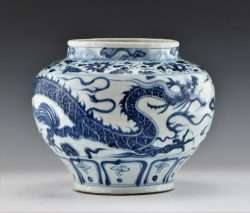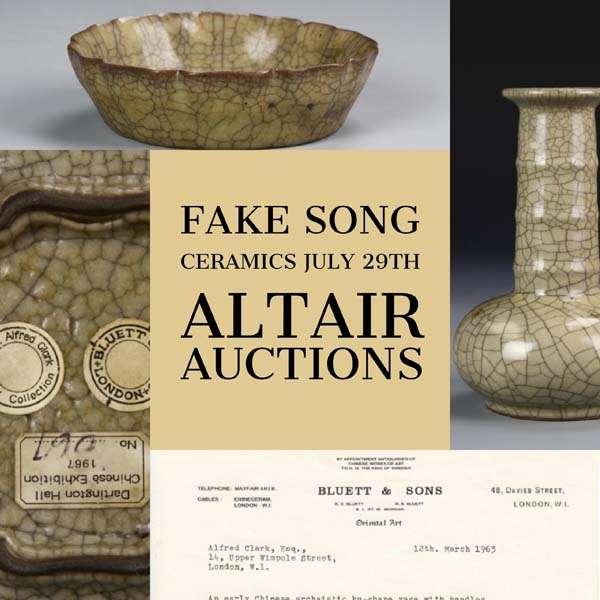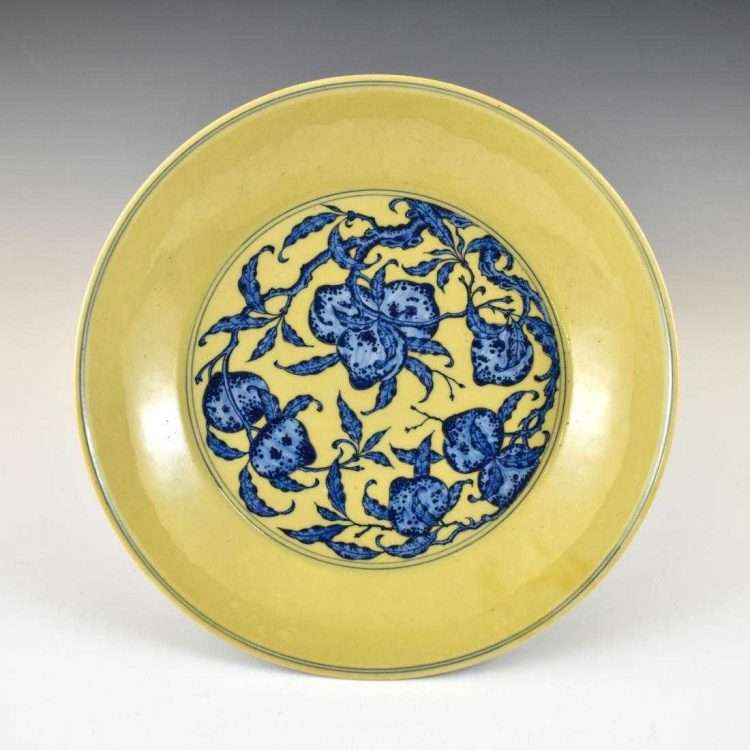Finding Auctions of Authentic Chinese Porcelain and art that's accurately described has never been easier nor more difficult all at the same time.
While this might sound contradictory, it's actually the truth and makes total sense. The advent of the internet created a massive environment for collectors to look for things, and at the same time opened the door to fraudsters and miscreant sellers of fakes of all qualities to confuse and misinform buyers. The web presents the ultimate double edged sword.

Modern Yuan-style Guan. (Fake) Advertised as authentic on Liveauctioneers.
A few things every collector and dealer should know and do.
Since the late 1990's armies of auctioneers and general "antiques dealers" with little to no knowledge of Asian art or history all jumped into the fray to cash in on the Chinese art boom.
Suddenly, almost overnight, everyone was an expert and some how had access to amazing collections comprising hundreds of objects on a near monthly basis.

Do not let "old receipts" fool you, they are now copying these too, including the names of very famous collectors.
Hundreds to thousands of auctioneers (and many dealers) today mis-represent themselves as experts, while in reality a minuscule number of them know anything at all.
How Auctioneers Try And Get Away With It
The defense, "We're not experts just the auctioneers, its up to you to decide. All items sold as is where is" (it's all bunk)
Today Auctioneers either advertise themselves as experts or simply feign ignorance of the fakes they sell. In both cases they simply try hiding behind the old auctioneers line.."I am just the auctioneer, you folks ARE the experts, all items sold as is, where is". This is true to some degree but depends 100% on whether or not the item is accurately described.
Auctioneers saying this, printing it and even when a bidder signs a registration agreement to that effect it's not in of itself a defense at all, not even close to one. Regrettably buyers have been conditioned to accept it as gospel. It is actually total fib in every state in the country.
"All Items Sold As Is, Where Is" The Auction Disclaimer Myth, Meet The UCC Code
"As is, where is" alone is meaningless, incomplete and violates the UCC Code of every state in the country if used alone as a defense against accusations of fraud or misrepresentation.
The actual full disclaimer clause is..."as is, where is, AS REPRESENTED." In other words it really means "We sell everything as is, where is and as described."
For decades this hackneyed line placed on most Auction House Disclaimers has been accepted at absolute face value serving as the auctioneers ultimate defense against accusations of misrepresentation. No auctioneer enjoys such immunity by sharing the "as is, where is" claim.
For example, if a blue and white bowl is described as "Chinese blue and white Xuande Bowl"..it means just exactly that. They are claiming to be selling an authentic MING XUANDE BOWL. No excuses later that they didn't know, or saying "as is, where is" provides total protection, it doesn't.
The bowl is either real or needs to be described as "style of", "manner of" or modified with another period date at a minimum.

High end copy of a Yongzheng peach dish, sold by Eden Galleries as Yongzheng Period, it is not authentic.
NOTE: If the auctioneer uses the description provided by a Consignor, the auctioneer by default accepts the liability and responsibility of it's accuracy if used in the listing or descriptions of the auction's contents.
NOTE: Even states that do not require Auctioneer licenses are still held to the Uniform Commercial Code aka the UCC Code. There is no getting away from it, period. Every state has it's own version, but are all basically the same to enable interstate commerce.
The Big Internet Image Proliferation, a dangerous source of often bad information.
As 99.9% of all auction houses know almost nothing about Chinese and Asian art beyond 19th C. Rose Medallion and Canton wares.
Note: Yes, even auction houses who know almost nothing on the topic DO sell authentic rarities, they just do it very rarely and unwittingly.
They usually find out once the item(s) hit the web and they get deluged with inquiries and large cash offers to sell the piece(s) before the auction. This happens, however very rarely. Proving the old adage, "A blind pig hits a root once in a while"
Regardless of this ignorance, auctioneers routinely load images onto websites, with inaccurate dating, attributions and poor descriptions. Those images stay on the web forever most of the time. All too often they are often assumed to be accurate representations of authentic items. This bad information is a curse for collectors and dealers who accept the information as gospel.
The internet is now by far the leading source of bad information regarding Asian Art.
This mountain of bad information, has cost collectors and some dealers thousands to over a million dollars in losses. (yes over a million dollars) The copies can be just that convincing.
So, what to do, what to do?
Rules for collectors and dealers. Finding Auctions of Authentic Chinese Porcelain and art
Before you can tell whether or not an auction item is authentic you need to think about a few things. You must ask yourself a few questions and don't let the thrill of obtaining a potentially great object cloud your judgement. You must also build a infrastructure of informational resources for yourself and some basic rules you'll always follow.
Part 1, The Auction House Reality Check
Ask yourself every time if not absolutely certain:
- Is the object to good to be true? Are there too many of them?
- For example, do you really think an authentic Chinese porcelain mark and period Doucai Chenghua Chicken cup, Qianlong Moonflask, or Xuande plate is really being sold at a minor US auction house instead of Christie's, Sotheby's, Bonhams, Doyles, I-Gavel, Heritage or Freemans? Yes it could happen, but is more unlikely than being struck by lightening twice in 10 minutes during a cloudless dry day in Arizona.
- Be honest with yourself, things that are RARE are just that RARE, meaning they almost never turn up on the market, why would anyone sell these things knowingly through a podunk auction house especially a purported collector? (no one would)
- Does the auctioneer seem to get too many purported rarities on a regular basis. Check his/her previous auctions and results. Do they seem to get very similar items sale after sale with prices far below market value?
- Does the auctioneer clearly state the age and authenticity of an item? If so, does the estimate coincide with similar items sold by the major auction houses? If not run for your life.
- Do you know REALLY know the difference between a very slick copy and an authentic item?
- If you're a subscriber to the BIDAMOUNT Global Member Pages check the "AUCTIONEERS REPORT CARD" data base. What Grade did they get?
Part 2, Reliable Sources For Information
First build a very good reference library of standard reference books and catalogs on the subjects you're interested in. Whether it is authentic Chinese porcelain you're after or jade, all of the rules are the same.
- Do not buy "General" books on the subject. If you like 18th C Famille Rose, buy books devoted to the period and not a compendium covering many centuries. If you like Song to Ming Bronzes, again buy up books on that specific topic leaving our Shang and earlier types.
- Auction catalogs, select catalogs which also tend to be more specific to your areas of interest. (Check our REFERENCE SECTION, we have over 500 catalogs and books on there.)
Museums Collections Online and Other Reference Sites:
- Freer Sackler Collection at the Smithsonian Washington DC.
- British Museum (this site is very poorly run and not always functioning)
- Metropolitan Museum NYC
- Alain R. Truong Auction Image Index on Bidamount.
- Auction Catalogs on Bidamount (Free)
- Books, on AMAZON
Part 3, Other Reliable Resources
The Value website A Hong Kong site with frequent video's and auction information.
Bidamount Global Member Auction Pages
Gotheborg Antique Chinese Porcelain
Join a Museum that offers regular lectures, exhibitions and information. There are many more, but here are a few for starters.
- Peabody Essex Museum, Salem, MA
- Metropolitan Museum, New York
- British Museum, "David Foundation"
- The Asia Society, NYC
- Kansas City Art Museum
- Seattle Art Museum
- Musee Guimet, Paris
In Closing Finding Authentic Chinese Porcelain and Other Asian Art Takes Time.
This is all just a start, get to know other collectors, reputable dealers and make a pint to visit any of the MAJOR auction houses during Preview Times for upcoming auctions. They are more than happy to answer questions and will alow you to handle most of the items being offered. NOTHING beats touching and handling objects, worth every minute of it. It's also a lot of fun. Most importantly ask lots of good questions.
Finding authentic Chinese porcelain and other Asian arts takes practice and experience, be patient and have fun doing it.
Leave a Reply